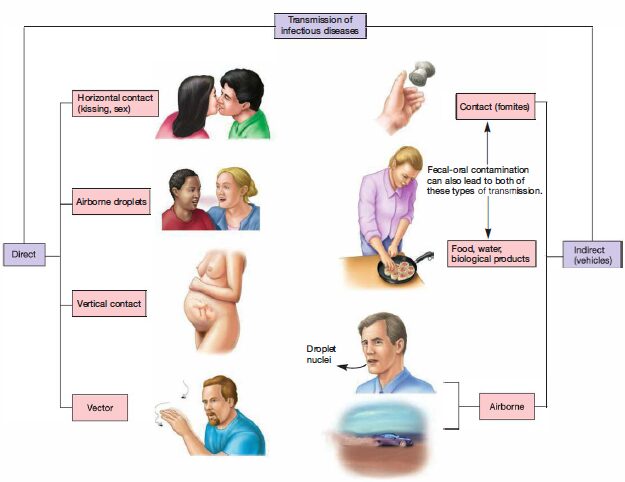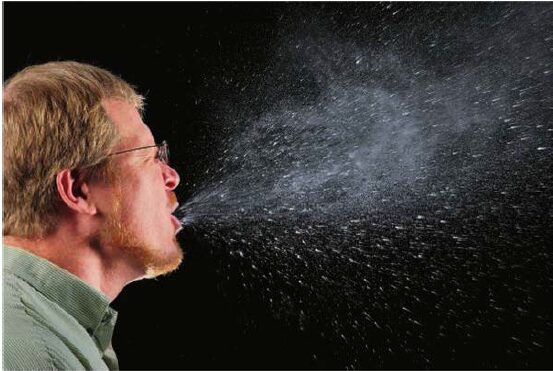Exposure and Transmission of Infectious Disease
Exposure and Transmission
An essential feature in the development of an infectious disease is the initial exposure of the host to the pathogen, the pathogen must be transmitted from one host or source to another. A pathogen’s virulence may be strongly influenced by its mode of transmission and ability to live outside its host. When the pathogen uses a mode of transmission such as direct contact, it cannot afford to make the host so ill that it will not be transmitted effectively.

This is the case with the common cold, which is caused by rhinoviruses and several other respiratory viruses. If the virus reproduced too rapidly and damaged its host extensively, the person would be bedridden and not contact others. The efficiency of transmission would drop because rhinoviruses shed from the cold sufferer could not contact new hosts and would be inactivated by exposure. Cold sufferers must be able to move about and directly contact others. Thus virulence is low and people are not incapacitated by the common cold.
On the other hand, if a pathogen uses a mode of transmission not dependent on host health and mobility, then the person’s health will not be a critical matter. The pathogen might be quite successful; that is, it may be transmitted to many new hosts even though it kills its host relatively quickly.
Host death means the end of any resident pathogens, but the species as a whole can spread and flourish as long as the increased transmission rate outbalances the loss due to host death. This situation may arise in several ways. In general, such pathogens are highly contagious.
Thus transmission is a critical component of the infection process and is the next link in the infectious disease chain, occurring directly or indirectly by four main routes:
- airborne
- contact
- vehicle
- vector-borne

Exposure alone is not sufficient for infection to occur. Rather, the pathogen must also make contact with the appropriate host tissue. For instance, rhinoviruses are spread by airborne transmission from one host to another. Once the virus makes contact with the upper respiratory tract epithelia, the virus invades to cause disease only in the upper respiratory tract; rhinoviruses do not usually infect anywhere else in the host.
This specificity is called a tropism (Greek trope, turning). Many pathogens exhibit cell, tissue, and organ specificities. A tropism by a specific microbe usually reflects the presence of specific cell surface receptors on the host cell for that microbe.
Airborne Transmission of infection
Because air is not a suitable medium for the growth of pathogens, any pathogen that is airborne must have originated from a source such as humans, other animals, plants, soil, food, or water. In airborne transmission, the pathogen is suspended in the air in droplets, droplet nuclei, or dust, which travel over a meter or more from the source to the host. Typically, this results from host-to-host interaction (coughing, sneezing).
Droplets form from saliva and mucus. They are 5µm or more in diameter and form when liquids are placed under force. The route of transmission to humans is through the air for a very short distance. As a result, droplet transmission of a pathogen depends on the proximity of the source and the host. Chickenpox and measles are examples of droplet-spread diseases.
Droplet nuclei are smaller particles, 1 to 4µm in diameter, that result from the evaporation of the larger droplets. In contrast to droplets, the much smaller droplet nuclei can remain airborne for hours or days and travel long distances. Contact with oral secretions may result when droplet nuclei contaminate body surfaces that touch mucous membranes (e.g., respiratory secretions on hands that contact eyes).

When animals or humans are the source of the airborne pathogen, it usually is propelled from the respiratory tract into the air by coughing, sneezing, or vocalization. For example, enormous numbers of moisture droplets are aerosolized during a typical sneeze. Each droplet is about 10µm in diameter and initially moves about 100 m/sec, or more than 200 mi/hr.
Dust also is an important route of airborne transmission. At times a pathogen adheres to dust particles and contributes to the number of airborne pathogens when the dust is resuspended by some disturbance. A pathogen that can survive for relatively long periods in or on dust creates an epidemiological problem, particularly in hospitals, where dust can be the source of hospital-acquired (nosocomial) infections. Many systemic mycoses (fungal infections) are examples of transmission in dust.
Contact Transmission of infection
Contact transmission implies the coming together or touching of the source or reservoir of the pathogen and the host. Contact can be direct or indirect. Direct contact implies an actual physical interaction with the infectious source. This route is frequently called person-to-person contact.
Person-to-person transmission occurs primarily by touching, kissing, or sexual contact; by contact with oral secretions or body lesions (e.g., herpes and boils); by nursing mothers (e.g., staphylococcal infections); and through the placenta (e.g., AIDS, syphilis). Some infectious pathogens also can be transmitted by direct contact with animals or animal products (e.g., members of the genera Salmonella and Campylobacter). Indirect contact transmission occurs when something “transfers” the infectious agent between hosts.
Vehicle Transmission of infection

Inanimate materials that indirectly transmit pathogens are called vehicles. In vehicle transmission, a single inanimate vehicle or source serves to spread the pathogen to multiple hosts. Examples include surgical instruments, drinking vessels, stethoscopes, bedding, eating utensils, and neckties. These common vehicles are called fomites (s., fomes or fomite).
A single source containing pathogens (e.g., blood, drugs, intravenous fluids) can contaminate a common vehicle that causes multiple infections. Food, water, and biological materials (fluids and tissues) are important common vehicles for many human diseases. They often support pathogen reproduction.
Vector-Borne Transmission of infection
Direct living transmitters of a pathogen are called vectors. Most vectors are arthropods (e.g., insects, ticks, mites, fleas) or vertebrates (e.g., dogs, cats, skunks, bats). Vector-borne transmission often benefits the pathogen by permitting extensive reproduction and spread within the host.
If pathogen levels are very high in the host, a vector such as a biting insect has a better chance of picking up the pathogen and transferring it to a new host. Indeed, pathogens transmitted by biting arthropods often are very virulent (e.g., malaria, typhus, sleeping sickness). It is important that such pathogens do not harm their vectors and the vector generally remains healthy, at least long enough for pathogen transmission.

Vertical Transmission of infection
Direct transmission of pathogens is not only mediated by horizontal, person-to-person passage but by vertical passage as well. Vertical transmission of pathogens occurs when the unborn child acquires a pathogen from an infected mother.
While vertical transmission does not occur as frequently as horizontal transmission, a number of microorganisms exploit this route, extending their host range. Babies born with an infectious disease are said to have a congenital (Latin: with birth) infection. Examples of congenital infections include gonorrhea, herpes, German measles, and toxoplasmosis.
Reference and Sources
- https://microbiology.nuph.edu.ua/wp-content/uploads/2018/10/3_2_study_Infection.pdf
- https://link.springer.com/chapter/10.1007/978-0-387-93835-6_5
- https://en.wikipedia.org/wiki/Infection
- https://quizlet.com/21586777/microbiology-test-2-flash-cards/
- https://quizlet.com/44684821/microbiology-chapter-35-flash-cards/
- http://www.dspmuranchi.ac.in/pdf/Blog/Pathogenicity,%20toxigenicity,%20virulence.pdf
- https://www.coursehero.com/file/p5pbo2ek/Airborne-transmission-occurs-by-dissemination-of-either-airbornedroplet-nuclei/
- https://quizlet.com/517754999/microbiology-exam3-flash-cards/
- https://www.annualreviews.org/doi/full/10.1146/annurev-fluid-060220-113712
- https://www.researchgate.net/publication/310766732_Arthropod_Borne_Diseases_-_ISBN_978-3-319-13883-1_ISBN_978-3-319-13884-8_eBook_DOI_101007978-3-319-13884-8
Also Read:
- Nitrogen Cycle
- Water as a Microbial Habitat
- Overview of lac operon an inducible operon
- Measurements of microbial growth
- Roles of Viruses In Aquatic Ecosystems
- Probiotics: Introduction, Development and Uses in Agriculture
- Innate Immunity: Description, Functions and Facts
- Roles of Viruses In Aquatic Ecosystems
- Plasmid: Properties, Types, Replication and Organization
- Whole-Genome Shotgun Sequencing: overview, steps and achievements
- Gel electrophoresis: types, principles, instrumentation and applications
- Transcription in prokaryotes: Initiation, Elongation and Termination
- Xanthan gum: Introduction, Structure, applications and Production
- CRISPR-Cas9 Gene editing tool: Introduction, Principles, Uses & Applications
